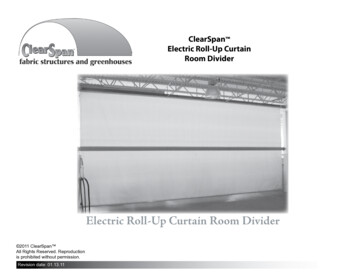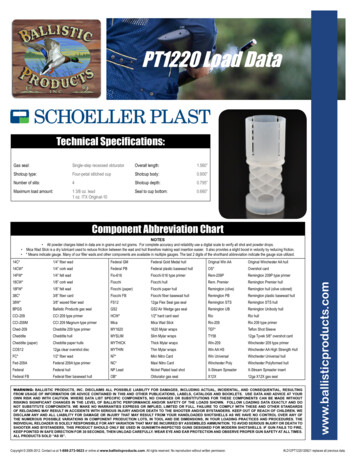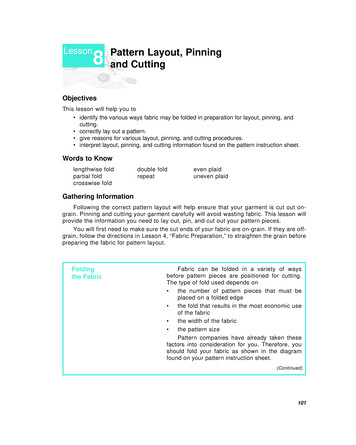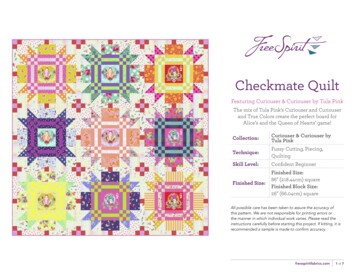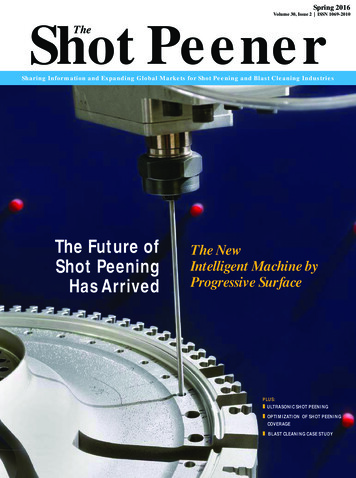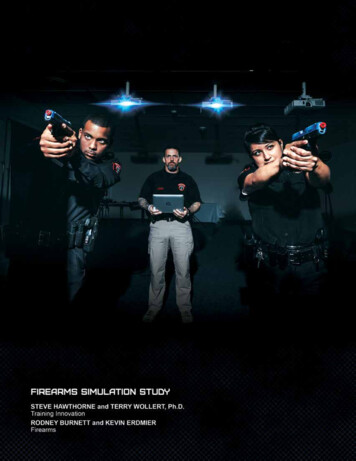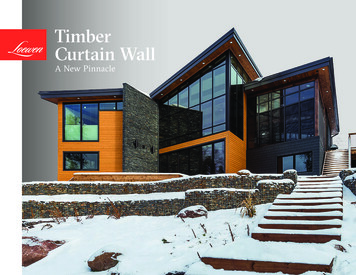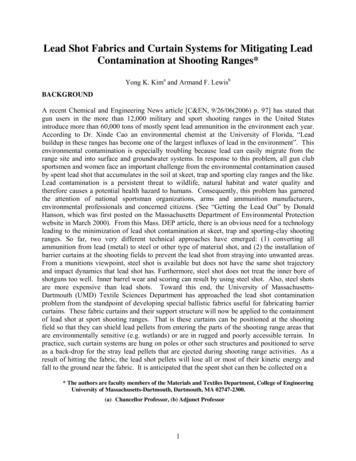
Transcription
Lead Shot Fabrics and Curtain Systems for Mitigating LeadContamination at Shooting Ranges*Yong K. Kima and Armand F. LewisbBACKGROUNDA recent Chemical and Engineering News article [C&EN, 9/26/06(2006) p. 97] has stated thatgun users in the more than 12,000 military and sport shooting ranges in the United Statesintroduce more than 60,000 tons of mostly spent lead ammunition in the environment each year.According to Dr. Xinde Cao an environmental chemist at the University of Florida, “Leadbuildup in these ranges has become one of the largest influxes of lead in the environment”. Thisenvironmental contamination is especially troubling because lead can easily migrate from therange site and into surface and groundwater systems. In response to this problem, all gun clubsportsmen and women face an important challenge from the environmental contamination causedby spent lead shot that accumulates in the soil at skeet, trap and sporting clay ranges and the like.Lead contamination is a persistent threat to wildlife, natural habitat and water quality andtherefore causes a potential health hazard to humans. Consequently, this problem has garneredthe attention of national sportsman organizations, arms and ammunition manufacturers,environmental professionals and concerned citizens. (See “Getting the Lead Out” by DonaldHanson, which was first posted on the Massachusetts Department of Environmental Protectionwebsite in March 2000). From this Mass. DEP article, there is an obvious need for a technologyleading to the minimization of lead shot contamination at skeet, trap and sporting-clay shootingranges. So far, two very different technical approaches have emerged: (1) converting allammunition from lead (metal) to steel or other type of material shot, and (2) the installation ofbarrier curtains at the shooting fields to prevent the lead shot from straying into unwanted areas.From a munitions viewpoint, steel shot is available but does not have the same shot trajectoryand impact dynamics that lead shot has. Furthermore, steel shot does not treat the inner bore ofshotguns too well. Inner barrel wear and scoring can result by using steel shot. Also, steel shotsare more expensive than lead shots. Toward this end, the University of MassachusettsDartmouth (UMD) Textile Sciences Department has approached the lead shot contaminationproblem from the standpoint of developing special ballistic fabrics useful for fabricating barriercurtains. These fabric curtains and their support structure will now be applied to the containmentof lead shot at sport shooting ranges. That is these curtains can be positioned at the shootingfield so that they can shield lead pellets from entering the parts of the shooting range areas thatare environmentally sensitive (e.g. wetlands) or are in rugged and poorly accessible terrain. Inpractice, such curtain systems are hung on poles or other such structures and positioned to serveas a back-drop for the stray lead pellets that are ejected during shooting range activities. As aresult of hitting the fabric, the lead shot pellets will lose all or most of their kinetic energy andfall to the ground near the fabric. It is anticipated that the spent shot can then be collected on a* The authors are faculty members of the Materials and Textiles Department, College of EngineeringUniversity of Massachusetts-Dartmouth, Dartmouth, MA 02747-2300.(a) Chancellor Professor, (b) Adjunct Professor1
matt fabric, sand or gravel bed so the lead can be recovered and recycled with overall minimalenvironmental impact on the surrounding areas.At the start of this project, some general specifications regarding the fabric and support structurerequirements were proposed by the UMD Lead Shot Curtain (LSC) project team. These arelisted below:(1) No permanent damage to the fabric material from multiple rounds of lead pellets shotfrom a shot-gun shooting at a distance of 100 yards (or less) from the target fabric.(2) Minimum “bounce back” of the pellets upon impacting the fabric.(3) Open fabric structure to minimize wind load on curtain.(4) Curtain system easily deployed; easily lowered in the event of heavy wind conditions.(5) Up to a five year outdoor weather-ability of fabric and support structure.(6) Easy repair and replacement of system components.(7) Curtain system must be of lowest cost to realize the desired features.This article summarizes the highlights of UMD Textile Sciences Department’s LSC technicaldevelopment effort. The project evolved from first studying the lead pellet ballistic impactbehavior of various fabric materials and then to designing a complete curtain support system.This work has culminated in the implementation of a LSC system demonstration projectinstallation at the Standish Sportmen’s Association (SSA) trap and skeet shooting club in EastBridgewater, MA (John Fabroski Club President). The following chronologically presents thetechnical results and details of this UMD LSC research and development project.SELECTION OF CANDIDATE FABRICSMany generic types of textile fabric materials, textile structures and forms exist. It was firstnecessary to choose what types of fabrics should be evaluated; from nylon to polyester yarnmaterials to woven, non-woven and knitted fabric structures. Based on the above criteria andour technical experience, the UMD Textile Sciences Department research team set out toevaluate a number of potential candidate fabrics. Since it is known that nylon and polyesteryarns are some of the toughest of the common textile fibers, these fabrics were first chosen forfurther study. Also, it was decided to evaluate knitted fabrics because they are indeed tough andcan be manufactured in a pattern that does not tear through (un-ravel) should they becomeopenly damaged.Since there exists no test for measuring the lead pellet impact ballistic characteristics of fabrics, asimple field test was developed by the UMD team. The principle of the test involved taking 5foot x 5 foot “model” fabric panels and mounting them in a PVC pipe frame and shooting atthem with lead (shot gun) pellets from various shooting distances. In this Lead shot ballistic test,the fabric test sample is mounted on a wooden frame positioned perpendicular to or “normal” tothe line of fire. This is the ZERO distance from which distance of shooting is based. Thesedistance positions are marked on a “straight line” from the target frame at say, 70, 80, 90 and 100yards from this ZERO target position. A picture of this test fabric set up is presented in Figure 1.Overall, the test is carried out by firing, from a sitting position, a total of five (5) shotgun shots atthe center of the 5 ft. x 5 ft. target fabric. In this test a 12 gauge lead shot shell of 2 ¾” length,2
HDCP, 1235 (feet per second) velocity, 1 1/8” oz. lead shot, size 7 ½ shot STS12NH7 was used.This particular ammunition was chosen because it has a higher kinetic energy upon impact thanthe typical ammunition used at most skeet and trap shooting ranges. Therefore, any rating offabrics by this UMD test method would be bias toward having the fabric rated to pass the test atgenerally higher than typical lead pellet impact intensity levels. After each of these five shot“rounds”, damage to the fabric is assessed. Fabric damage is recognized as yarn and fiberbreakage, pellet holes, captured pellets at the point of pellet impact. The fabric’s performanceis rated in terms of the shortest shooting distance where NO DAMAGE is observed in the leadpellet impacted fabric. Test values are presented in terms of the Per Cent of Non-Damage pelletHits or PNDH.Table 1 presents results of some fabrics that were tested by the aboveprocedure. Included in Table 1 are some fabrics that are presently being used for lead shotcurtain applications.Figure 1: UMD In-Field Lead Pellet Impact and “Bounce-Back” Test for EvaluatingExperimental LSC Fabrics. (A Framed 5 foot by 5 foot Fabric Test Panel is shown)Of interest, neither of the presently used fabrics for LSC applications, a woven vinyl/nylonscreen fabric nor the Polymax (open knit polyolefin) lead shot curtain fabrics passed this UMDLSC field test at 100 yards distance. From these and various other fabric testing experiments,some direction was established as to what textile materials and processing technology should befurther examined in order to make suitable lead shot ballistic fabric materials. This informationis summarized:3
(a) Nylon Curtain Material (Passes UMD Ballistic test at 100 yards(b) Hope/Global H/G 200X (PET) – Passes UMD’s Ballistic test at 80 yards(c) Nylon (Black) Curtain Material Passes UMD Ballistic test at 75 yards. This fabric is verystiff and does not “drape” well.Table 1: Some Fabrics Tested for Lead Shot Curtain Applications (a)Fabric (see footnotes)*Areal Density(gms/meter2)Nylon-MSHR675F(Knitted, Black)436Hope/Global -Knit, WhitePNDH**(%)10010098%TotalPelletsFalling Within 2 Feetof FabricNA294510010034859321Hope/Global 200X (PET)(Warp-Knit, Gray)226807570100100100121612POLYMAX 70% screen(Knitted, Black)1751008575NA 4473585774Nylon/vinyl Screen(Woven, Green)4171008575989337555245*FABRIC DESCRIPTIONNylon-Knit Black 100% Nylon, 675F (Gehring Textiles, Garden City, NY)H/G 100X1- Warp Knit nylon fabric. Hope Global, Inc., Cumberland, RIH/G 200X - Warp Knit Polyester (PET) fabric. Hope Global, Inc., Cumberland, RIPOLYMAX is a knitted, monofilament, Polyethylene Screen fabric available inseveral % shade screen densities. Tek-Supply, Dyersville, IAWoven Screen – Green colored vinyl-coated, nylon yarn woven into an open mesh.Product supplied by Hammer & Sons Sign Company, Pelham, NH.PNDH - - - Per Cent Non-Damaging Hits by the impacting lead shot pellets.NA - - refers to the fact that the pores or openings in this fabric were so large, that at 100 yards, many of the leadpellets (nominally, 2.4 mm diameter) passed through the fabric without damaging the filaments. However, at 85 and75 yards, broken and distorted filaments were observed.From these data, a decision was made to pursue the development of Lead Shot Curtain fabricsmade using the warp-knit process and having an areal density of (nominally) between 100 and400 grams per square meter. Of significance, the warp-knit process is a most versatile of all4
textile processes. Fabrics can be manufactured in widths up to 200 inches using the warp-knitprocess. Following this and the results of Table 1, it was decided that polyester (PET) basedyarns would be used as the fiber material. The rational for using PET is based on the fact thatPET yarns are the most mechanically and environmentally durable among the common textilefiber/yarn materials. PET yarns are also of relatively low cost. As a result of numerous warpknit fabric development trials, a polyester based, “80-yard fabric” has evolved and was chosenfor further field demonstration testing. This fabric has been assigned the trade name XXXXXTM80 to convey the fact that the fabric can block lead pellets from landing into unwanted areas.XXXXXTM 80 has been shown not to be damaged by shotgun dispensed lead pellets from adistance of 80 yards from the shooter. In fall 2004, actual shooting range-field tests were carriedout on a large sized curtain assembly (20 foot x 34 feet) at the Standish Sportsman’s Associationrange. The fabric showed no damage after multiple rounds of lead shot (skeet range) at an 80yard distance. In this trial, while the fabric performed very well, the curtain size was found tobe too large to be conveniently handled and supported. From this experience, it was decided thatnarrower curtain widths should be submitted for shooting range field evaluations.In addition to blocking lead pellets, the use of lead shot curtains at shotgun shooting rangesshould offer a means of facilitating the recovery and recycling of lead shot. Appropriatelypositioned lead shot barrier/curtains can serve to confine the field areas where the spent lead shotcan land thereby lessening the exposed land area required for lead shot recovery. At someexisting shooting ranges, a large ground fabric is positioned on the ground in front of the leadshot barrier curtains to catch the fallen lead pellet. In other instances, sand or gravel beds havebeen placed in the vicinity of the barrier curtains. These lead shot capture systems require thelead pellets to be collected from the “geo-textile” fabric mat or else sifted out of the sand orgravel. If barrier curtains and on-the-ground capture matt design areas can be developed that areable to confine the spent lead shot to a smaller “contaminated” area, the ease of anyrecovery/clean-up/recycling effort could be greatly reduced. Table 1 presents data on the“bounce back” characteristics of the various fabrics tested. Here, during the test, a ground areaup to eight feet in front of the 5’ x 5’ test curtain (Figure 1) was first covered with a white“blanket” of non-woven fabric. After shooting 5 rounds for the test, the total number of pelletsthat bounced back from the fabric upon impact is counted. The data in Table 1 presents thepercent of the total number of bounce back pellets that fell within two feet in front of theimpacted fabric curtain. Qualitatively, at least, the higher percentage of pellets that fall withintwo feet of the curtain, the better this fabric is in containing the ricochet of the pellets once theyhit the fabric target. While some fabrics might be better than others, it was noticed that thisbounce back value also depends on the drape qualities and physical tension put on the fabric testcurtain panel mounting during the test; the more drape in the fabric and the lower the mountingtension, the shorter the pellets would bounce back away from the front of the curtain surface. Onthe other hand, the further the lead pellets bounce back off the curtain fabric, the less kinetic(impact) energy if absorbed by the fabric. The characteristics of pellet bounce-back, lead pelletcapture and recovery are the subjects of future UMD research and development studies.SUPPORT SYSTEMS FOR LEAD SHOT CURTAINSWhile the development of ballistically durable fabrics for LSC applications is pivotal to thisresearch, another important issue is the actual structures that can be used to support these5
developed fabric curtains. As a preview to our study of the LSC support structures, during thefall of 2003, several gun clubs were visited by UMD personnel. Here we learned about what hasalready been done at several gun clubs concerning LSC curtain installations. These gun club sitevisits provided some very useful insights to the technical needs of Lead Shot Barrier Curtainsystems and structures. At one club, an installation of 19 telephone poles, spaced 8 feet apart,approximately 80 yards from the trap field firing line was observed. The total spread of thisinstallation was about 144 feet. The pole length above the ground was 60 feet. Here, a 5 footwide section of Green Woven Screen fabric (see Table 1)[available from Hammar & Sons SignCompany, Pelham, NH] was hung, 2 feet from the top of each pole, to span across the 19 poles.Two additional rows of 5 foot wide Woven Screen fabric were hung below this initial topsection. These fabric panels were secured to the poles by 1 x 5 pine boards nailed to the poles.The total length (top to bottom) of the Lead Shot Curtain was 15 feet. All three sections of fabricwere supported by 1/4" steel cable. This prevented sagging of the fabric sections between thepoles. This was a somewhat permanent installation that was poorly maintained. The fabricshowed extreme damage by the lead pellets indicating the poor performance of the wovenvinyl/nylon screen fabric. This fabric is a vinyl coated nylon filament yarn, fine mesh (screenlike) woven structure whose mesh has been heat fused together to make a drape-able curtain.Unfortunately, neither vinyl nor nylon is very resistant to long term UV exposure andweathering. Also, vinyl coatings do not have a good abrasion resistance. At this club, this greencolored woven screen fabric has been replaced and/or patched-up several times during the past 3years. The appearance of this particular LSC installation was very poor. Nevertheless, thisinstallation is applauded for its effort to prevent lead contamination of the surrounding soil.At another gun club, 11 telephone poles were installed 50 feet above the surface (buried 5 feetdeep). These poles were in a row placed 20 feet apart and 105 yards back from a trap stationfiring line. 20 foot wide, 34 foot long sections of barrier curtain were prepared from the samewoven vinyl/nylon screen fabric material that was used at the previous club. These fabricatedfabric panels were supported at the top with 20 foot lengths of 1 ¼ inch black iron pipe and atthe bottom with 1 ¼ inch PVC pipe. These 20 foot wide panels were then hung between thepoles starting at 2 ½ feet from the top of each pole and extending 34 feet downward. Thiscurtain assembly was not secured at the bottom; the curtain was allowed to drape and swingsomewhat freely at the bottom. With less tension on the fabric, this served to make the curtainfabric more impact resistant. Of interest, a cable and pulley arrangement was attached to each 20foot wide (iron pipe boom) section between the poles so the curtain could be easily lowered incase of very high winds or else if maintenance of the curtain was needed. A zone of rocks andgravel was deposited in front of this curtain to serve as a lead shot drop area. It was not clearwhen and how the lead shot would be removed from this rock/gravel mixture. Here also, thegreen woven vinyl/nylon screen curtain fabric material was observed not to be holding up toowell to the barrage of lead shot pellet impacts and the 2 years of outdoor weathering.Replacement of the fabric at this club was pending. However, the functional service of thisparticular lead shot curtain installation was, overall, much better than the previously describedinstallation. This gun club should also be commended for its environmental protection efforts.Overall, the fact that fewer poles are used and this system had the feature of the facile raising andlowering of the 20 foot wide curtain panels indicates that the design was well thought out. Inview of this learning experience, plans were developed to design a UMD experimental lead shot6
barrier curtain system. This was done in consideration of the previously outlined criteria in aprevious section of this review article.(1) Positioning of Lead Shot Curtains and Support StructuresPresently the use of strategically positioned lead shot barrier curtains are considered to be thebest immediate solution to the lead shot environmental migration issue. The location of a curtainbarrier system on a particular shooting range is very important. However, it is difficult todetermine this from first principles of physics and engineering. This is based on the realizationthat calculating the projectile dynamics of lead shot blasted from a shot-gun is not straightforward. A shotgun blast does not involve the ejection of a single projectile. Multiple (leadpellet) projectiles are involved. Therefore, multiple intra-pellet collisions occur during a shotgun blast making calculations very difficult. However, some generalizations have beenestablished. For example, the projectile patterns at a typical trap shooting range and theoreticalshot-fall zone are diagramed in Figure 2. As shown, the pellet shot fall pattern spreads out afterabout 100 yards from the shooting position.Figure 2. Theoretical shortfall zone and maximum shot-fall at trap fields. The cross-hatchedarea indicates maximum shot-fall zone. [National Shooting Sports Foundation, Facility Development Division,“Environmental Aspects of Construction and Management of Outdoor Shooting Ranges, NSSF, Newtown, CT(1997)]This gives one a measure of how wide the curtain assembly should be spread across theprotection area in a typical trap field setting. Another important parameter is how high thecurtain should be positioned above the trap field, and of course, how long the curtain shoulddrape down. It has been found the most effective way of determining the height and length of7
lead shot curtains is to determine these parameters from “trial and error” methods. Data areavailable from the various gun clubs who have observed the pattern/location of lead pellet impactfrom their experience. From this, some general distance and curtain barrier area dimensionshave been empirically established. For example, at a trap shooting range needing to block pelletsat 80 yards from the shooter, the LSC fabric should be placed at a top height of 50 feet above theground and drape down to 16 feet above the ground. Therefore a 34 foot long fabric curtainsystem will be needed for this particular trap shooting range. For ranges with shorter shootingdistances, narrower curtains will be needed; for longer shooting distances, wider and longer (topto bottom) curtains will be required. Finally it must be stated that the exact positioning of theLSC system at a shooting range will always depend upon the terrain topography of the particularrange and also what parts of the range must be most effectively protected from lead shotcontamination. In other words, the positioning of the LSC barrier structures will always beunique to the particular shooting range being “fitted” for a LSC system.(2) Specifications for LSC Support StructuresWith the relevant positioning of the curtain structure is of initial concern, there are longevityconcerns. Since the curtain and structure is subjected to the pelting of shot, sunlight, wind andother weathering factors, the curtain will have to be replaced in a few years. Other clubs thatmay be interested in erecting a shot capture curtain are also concerned about the durability andoverall life span of the curtain and support structure to insure a cost-effective lead shotmanagement program.From our research and field studies some performance criteria have been proposed for Lead ShotCapture Systems. These are listed below: Fabric should be damage resistant to impact by multiple rounds of lead shot pellets shotat a specified distance. Fabric and support system should have a five-year outdoor weather-ability. Fabric should have a minimum “bounce back” of pellets upon impact. Fabric material and support system should have a low wind-drag coefficient. Fabric barrier system should be easily deployed, easily repaired. Fabric support system should allow for the easy lowering or furling of the fabric curtainsin impending high wind and/or severe weather conditions. The system should be of a low cost/performance ratio. The complete system should have a respectable appearance(3) Standish Sportsmen’s Association (SSA) Demonstration InstallationLate in 2004, a “Demonstration Project” was initiated at the Standish Sportsmen’s Association(SSA) Club, East Bridgewater, MA. Here, UMD agreed to help this club set up an experimentalLSC system by supplying them with the needed LSC assemblies. Having established the abovecriteria, a number of curtain support system arrangements have evolved. From our own ideasand suggestions derived from reviewing existing installations, it was concluded that the mostprominent curtain system involves the setting up of 50 to 60 foot high (out of the ground) polesset 20 feet apart across the back section of the shooting field. The curtain/pole installationdistance from the shooter it determined by the barrier protection limits of the particular LSCfabric. For XXXXXTM 80, this would be 80 yards. In this demonstration project, SSA agreed toinstall eleven poles at their site and affix them with support and mounting cables, pulleys and8
tethering lines. To the top section of these poles was fixed a set of two cables- - - - one cablecantilevered out 12” to 18” in front of the pole and the other cable cantilevered out 12” to 18”away from the back of the pole. This arrangement was designed so that curtains could be hungonto this “continuous” double cable without concern for the distance between the poles. Here,UMD was responsible for supplying SSA with the 20 (twenty) curtains for mounting onto thispole and cable assembly.XXXXXTM-80 LSC fabric is supplied by Hope Global, Inc. Cumberland, RI in 8 ½ foot widths.Therefore curtains were sewn having the dimensions of 8½ foot wide by 34 feet long. Thiscurtain length was determined by some preliminary shot fall studies (Figure 2) and dictated bythe particular dimensional needs of the SSA site. From these dimensions, a curtain fabricassembly was then prepared. This is diagramed in Figure 3. This curtain features a top boomconsisting of 1 ½ “ diameter galvanized steel conduit pipe. This top boom was inserted into the6” wide hem at the top of the curtain. Another boom, a 1 3/8” diameter galvanized top rail fencepipe, is inserted into the 6” hem located at the bottom of the curtain. In order to steady the shapeof the curtain under windy conditions, two “battens” were placed at the (approximate) one-thirdpositions along the 34 foot “drape” length of the curtain. Attachment clamps were then affixedto each end and in the middle of each boom. This attachment hardware also served to secure thecurtain to the booms.9
Figure 3: XXXXXTM 80 Fabric Curtain Design and Dimensions -“Standish”Model (not to scale)Mounting these curtain assemblies to the SSA support system involves securing them with ropeand pulley fixtures, to the double cable system fixed (and off-set) at the top of the poles.To alleviate the effect of unexpected wind stresses, the Standish Sportsman’s Association Club,(Mr. John Fabroski and the club members) have come up with the idea of fitting each individualcurtain with a double row of cable lines such that the curtains would be able to be folded up onitself. This requires the top boom of the curtain to be permanently fixed to the top cables of thesupport system. Now, to collapse the curtain, one has to only pull on the rope line attachedthrough the grommeted lines that were fitted through the curtain face. The curtain would then10
fold up upon itself and finally be stored in a “bundle” at the top of the support poles and crosscable. Part of this SSA LSC fold-up curtain installation is pictured in Figure 4. It represents aLSC support structure installation arrived at by the joint cooperation between UMD and SSA’sPresident, John Fabroski and his club members. The SSA group continues to carry outexperimental studies on their LSC support system.Figure 4: Photograph of Lead Shot Curtain Structure at the Standish Sportsman’sAssociation Range, East Bridgewater, MAThe general rule for this described LSC installation, as stated by SSA members, should be “if indoubt, take down or fold up the curtains” after each shoot. Overall, the subject SSA installationis performing as intended. It is blocking lead pellets from falling into unwanted land areas. Theperformance of this demonstration installation will continue to be monitored.(4) Some Additional LSC Support Systems Suggested by UMass DartmouthAn important consideration in the design of LSC support systems is the use of a truss structureacross the tops of the poles. Truss structures are widely used in the field of overhead highwaytraffic and directional signs. In LSC systems, a truss structure across the top of the poles isrecommended over the double cable set-up as described in the Standish Sportsmen’s Associationinstallation. Overall, the truss structure will help distribute the stress across the series of polesand will enable the curtains to be hung without sagging which is prominent in the cable-acrossthe-pole-top method described (see Figure 4). It is recommended also that the poles beappropriately guyed to ensure their stability under wind load stresses. A sketch of the truss11
structure across the tops of the poles is shown in Figure 5. Here, a box truss structure is shown.The use of a box truss allows for the curtains to be mounted in different ways.Figure 5: Box Truss Structure Positioned at Top of LSC Support Poles. Poles must beproperly guyedOne configuration involves mounting the curtains in a more or less straight overlap as shown inFigure 6 (top picture). Another more preferred configuration is having the LSCs mounted in alouvered mode (bottom picture) also shown in Figure 6.12
Figure 6: Top View of Different LSC Hanging Installation Modes (Type A – StraightOverlap, Type B – Louvered Overlap)Three 8 ½ foot wide curtain assemblies can be positioned, in a “louvered” configuration,between each 20 foot wide spacing between the poles. The louver top width should be between18” and 24” in width to allow for enough open louver. One end of the top boom is secured to thefront cable or Box Truss structure and the other end is secured to the back cable or back of theBox Truss structure. If a box truss structure is used, a back cable offset structure must beinstalled to fix the other end (or side) of the curtain to keep the curtain’s left and right sides 18”to 24” away from each other. This louvered curtain arrangement is sketched in Figure 7. Thispositioning allows for each curtain (with battens) to over/under-lap each other with enough spacebetween each curtain for the wind to flow through. Most importantly, this louvered assembly canserve to help reduce wind loads on the curtain when the wind is coming in the open directiontoward the13
Figure 7: Sketch of Lead Shot Curtain- Louver Design (not to scale). (Note: Cable acrossbottom section of poles to hold tethering lines not shown in this diagram-refer to Figure 5).open slots of the louver. In such installations, the “louver direction” must be selected so as toaccommodate the direction of the passing prevailing winds. Another feature that can beimplemented with this design is the installation of elastic (bungee cord) tethering lines on t
practice, such curtain systems are hung on poles or other such structures and positioned to serve as a back-drop for the stray lead pellets that are ejected during shooting range activities. As a result of hitting the fabric, the lead shot pellets will lose all or most of their kinetic energy and fall to the ground near the fabric.
